#Guyanese History
Explore tagged Tumblr posts
Text
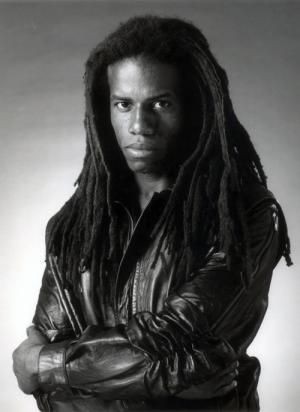
Good morning 💜 #BHM
Black History Month
Edmond Montague "Eddy" Grant
Muscian, vocalist, producer, Ice record label owner, music publisher, Blue Wave studio owner and owner of Ice Records.
Eddy Grant was born 5 March 1948 in Plaisance, British Guyana. He came to England in 1960 when his parents sent for him to join them in Stoke Newington London.
In 1965, Eddy formed his first band, the Equals, long before the days of 2-Tone, the group was unique in being the first of Britain's multi-racial bands to receive any recognition. The West Indian contingent comprised of Jamaican-born singer Lincoln Gordon, with his twin brother Derv and Grant both on guitar, while the rhythm section of bassist Patrick Lloyd and drummer John Hall were native-born white Englishmen.
Eddy went onto have a successful solo career both sides of the Atlantic, his hit Electric Avenue was inspired by the Brixton riots.
Eddy Grant stands among an elite group of artists as one who has not just merely moved successfully across the musical spectrum, but has actually been at the forefront of genres and even created one of his own. From pop star to reggae radical, musical entrepreneur to the inventor of ringbang, the artist has cut a swath through the world of music and made it his own.
Credit:
Jo-Ann Greene
Source:
https://www.allmusic.com/artist/eddy-grant-mn0000796763/biography
#good morning#black art#positive vibes#Eddy Grant#black british history#black history#Guyanese History
1 note
·
View note
Text
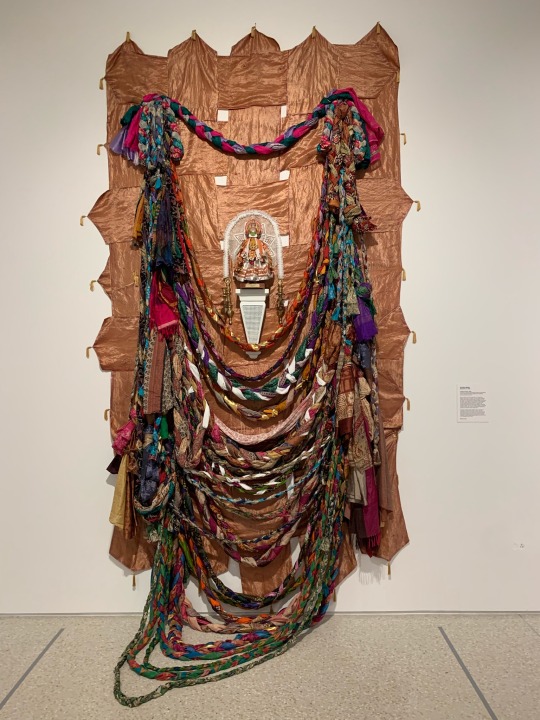
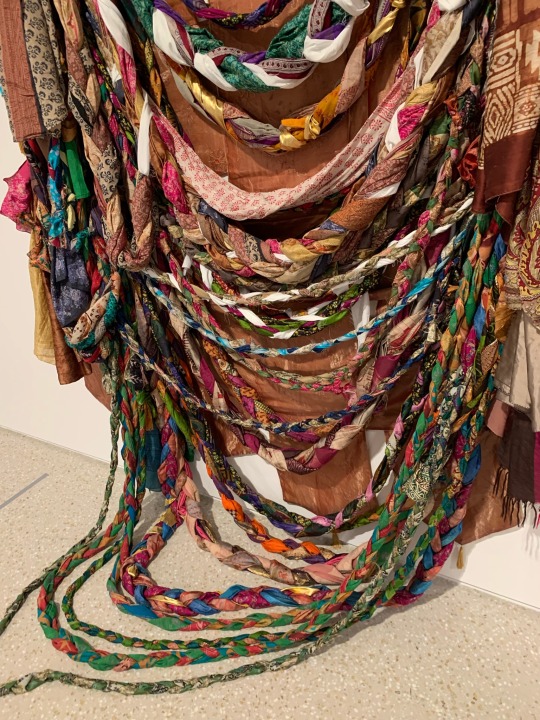

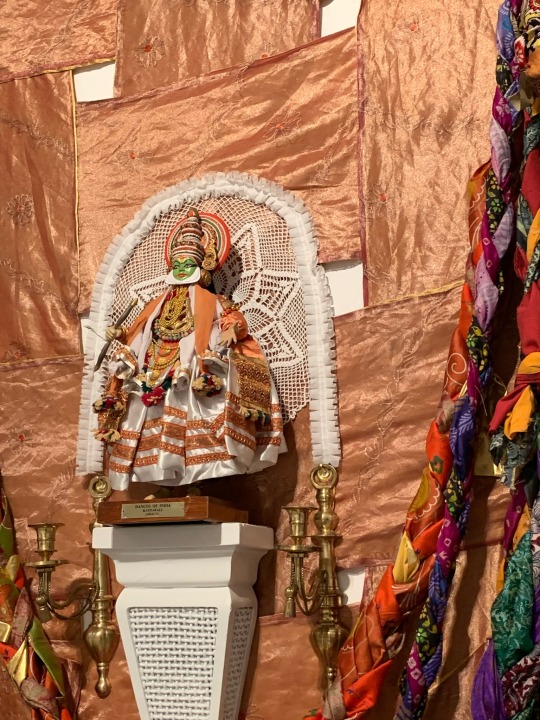
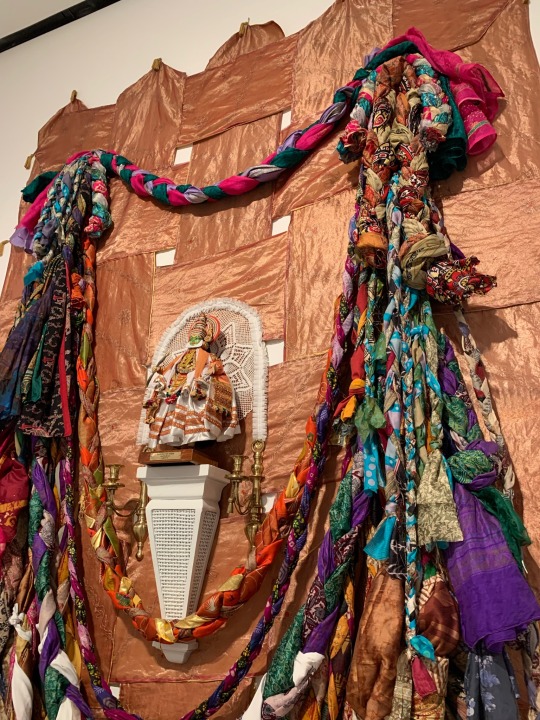
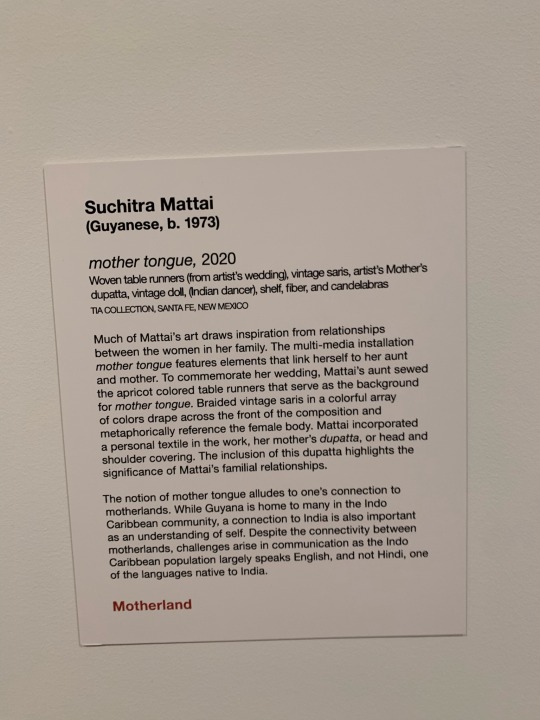
mother tongue (2020) Suchitra Mattai
#art#art stuff#museum#art appreciation#art history#fine art#suchitra mattai#guyana art#guyanese#guyana#mother#sari#fabric art#fabric#textile art#textiles
36 notes
·
View notes
Text
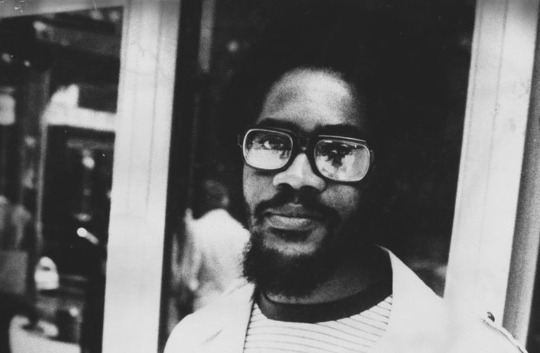
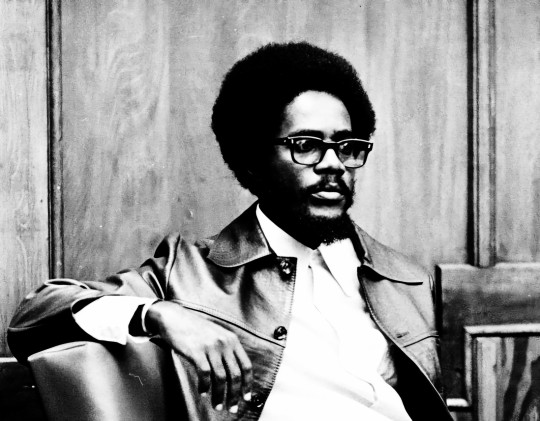
Walter Rodney (1942–1980) was a prominent Guyanese historian, political activist, and scholar whose work and activism significantly influenced Pan-Africanism and anti-colonial struggles in the 20th century.
Rodney earned his PhD in African history from the School of Oriental and African Studies (SOAS) in London in 1966, with a focus on African resistance to European colonization. His landmark book, How Europe Underdeveloped Africa (1972), became a seminal text in Pan-African studies, critiquing the exploitative relationship between Europe and Africa and exposing the ways in which colonialism stunted Africa's development.
A committed Marxist and Pan-Africanist, Rodney believed in the liberation of all oppressed peoples and was deeply engaged with grassroots movements. He travelled extensively, including in Tanzania, where he taught at the University of Dar es Salaam and advocated for African socialism and self-reliance.
Rodney’s activism often puts him at odds with political elites. In 1968, he was banned from Jamaica after criticizing the government and the capitalist structures that perpetuated inequality. This led to the famous “Rodney Riots,” as his followers protested his expulsion, sparking broader conversations about social justice.
In his native Guyana, Rodney co-founded the Working People's Alliance (WPA) to challenge the authoritarian rule of Forbes Burnham. His outspoken opposition to oppression and his advocacy for the working class made him a target of state repression. On June 13, 1980, Rodney was assassinated in Georgetown, Guyana, under circumstances widely believed to involve state security forces.
Rodney’s life and work continue to inspire Pan-Africanists, social justice advocates, and scholars worldwide. His legacy is one of unwavering dedication to the struggle against imperialism, racism, and inequality. 🇬🇾
#black people#black history#black#black tumblr#blacktumblr#pan africanism#black conscious#africa#black power#black empowering#walter rodney#guyana#guyanese#african culture#afro Caribbean#How Europe Underdeveloped Africa
41 notes
·
View notes
Text

Pepperpot is an Amerindian-derived dish popular in Guyana. It is traditionally served at Christmas and other special events. Along with chicken curry, and cook-up rice, pepperpot is one of Guyana's national dishes. Pepperpot is a stewed meat dish, strongly flavoured with cinnamon, cassareep (a special sauce made from the cassava root) and other basic ingredients, including Caribbean hot peppers. Beef, pork, and mutton are the most popular meats used, though some have been known to use chicken. Pepperpot is popularly served with a dense Guyanese-style homemade or home-style bread, rice, or roti. It can also be served with boiled vegetables such as cassava, eddoes, sweet potatoes, and green or ripe plantains. This dish is usually reserved for special occasions because it needs to cook for several hours, and mostly eaten on Christmas Day or during the Christmas holiday season, and sometimes on Boxing Day. Like the original Amerindian version it is usually made in a large pot and can be reheated and eaten over several days because the cassareep starts preserving the meat. Versions of the dish are also served in several other countries in the Caribbean, including Trinidad and Tobago, Grenada, St. Vincent and Jamaica. src.: Albala, Ken (2011). Food Cultures of the World Encyclopedia. ABC-CLIO. p. "national+dish" 161. ISBN 978-0-313-37626-9, Goucher, Candice (2014). Congotay! Congotay! A Global History of Caribbean Food. Taylor & Francis. p. 57. ISBN 978-1-317-51732-0
27 notes
·
View notes
Text
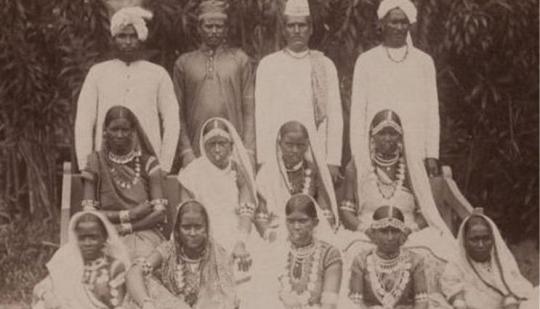
Indian immigrants to Guyana in the 1800’s
To be precise, I am an Indo-Guyanese-American: The mother of all hyphenated identities and an illustration of a historic journey from India to the Caribbean. This heritage is commonly packaged in a number of different terms, all of which are heavily used as referential identifiers: Indo-Guyanese. Indo-Caribbean. Caribbean. West Indian. Indian. It is most aptly described as the Indo-Caribbean experience—an experience that is shared by Indians living throughout the Caribbean diaspora and thus serving as the blueprint for my existence.
This unique cultural disposition is why the Indo-Caribbean are able to culturally identify with public figures ranging from Hasan Minhaj to Nicki Minaj. It is why bursts of Caribbean intonation in Rihanna’s voice blanket me in the comfort of home, while the ballads of A.R. Rahman awaken pained demons within me, crying to connect with a history that was ripped from my hands long before I was born.
My parents hail from Guyana, a small country on the northern coast of South America. Guyana is one of the original colonies of the British West Indies and, although not located in the Caribbean Sea, the CARICOM Seat of Secretariat is located in Georgetown, Guyana, thus rendering the country a crucial member of the Caribbean family. [Read more]
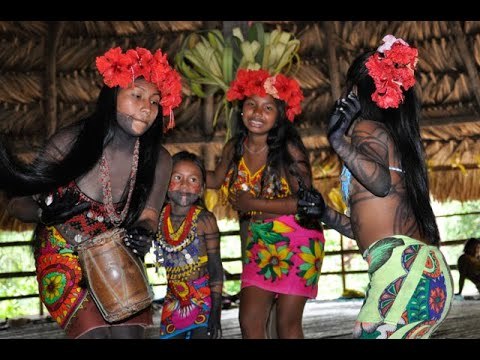
63 notes
·
View notes
Text
Decolonial Marxism - Walter Rodney
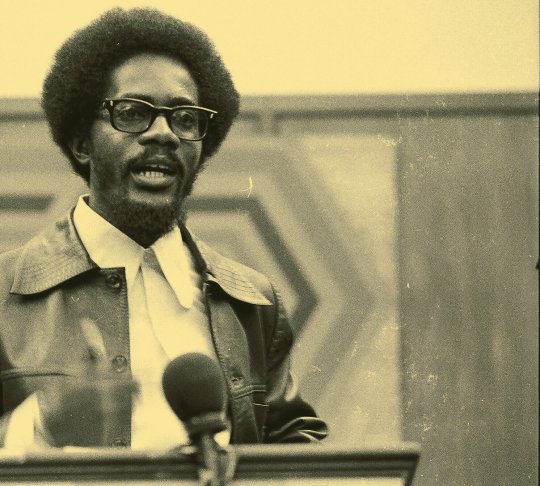
Hello friends!
Today's recommendation continues the focus on revolutionary thinking from important figures in the Global South with a compendium of wonderful essays that are incredibly relevant today: "Decolonial Marxism" by Walter Rodney.
Walter Rodney was am inimitable historian, educator, and political activist who forwarded Pan-Africanist and Marxist thinking and action since the 1960's. His groundbreaking historiography on Guyana and research in Tanzania produced works like "How Europe Underdeveloped Africa," his magnum opus that forwarded a rigorous analysis on the ways colonialism ransacked the African continent as a piece of postcolonial literature. He also became actively involved in the Black Power movement, fostering alliances with prominent figures like Angela Davis and Kwame Ture. His tireless efforts to unite oppressed peoples around the globe earned him admiration and support from many, alongside angering institutions like the US-backed Guyanese government which were likely sources of his assassination in 1980.
"Decolonial Marxism" delves into the intersection between Marxism and the postcolonial struggles faced by former colonies around the world, challenging the view that these theories are ultimately Eurocentric. In this collection of posthumous essays, Rodney evaluates how Marxism can be harnessed to address the structural issues perpetuated by colonialism and foster decolonization, while also criticizing actually Eurocentric views present on this revolutionary tradition.
Incredible strengths of this view lie in Rodney's analysis of how class society is intrinsically connected to the legacy of slavery and colonialism alongside a study of African history on its own terms as a Marxist, alongside his thinking of what a Pan-Africanist Marxist revolutionary struggle can look like. He takes inspiration from Tanzania's Ujamaa to flesh some of these investigations out, which I highly recommend.
"Decolonial Marxism" goes beyond theory; it provides historical examples and case studies that demonstrate the practical implications of anti-colonial Marxist thought, which makes it a must read in my book.
#book blog#book review#bookblr#decolonisation#marxism#anti colonialism#walter rodney#pan africanism#global south
20 notes
·
View notes
Note
hi! i hope you dont mind the ask! im looking to set up a period fc and just looking to get some fc help! i want the group to be diverse as possible and was hoping you could help with some fc suggestions?
Kathy Bates (1948) - American Horror Story as Madame LaLaurie.
Richard Ridings (1958) - Dickinson.
Michelle Yeoh (1962) Chinese Malaysian - The School for Good and Evil.
Zahn McClarnon (1966) Hunkpapa Lakota, Sihasapa Lakota, White - History of the World, Part II.
Sophie Okonedo (1968) Nigerian / Ashkenazi Jewish - The Wheel of Time, The Hollow Crown.
Adrian Lester (1968) Afro Jamaican - Mary Queen of Scots.
Yuliya Aug (1970) - Ekaterina.
Warwick Davis (1970) - Willow - has spondyloepiphyseal dysplasia congenita.
Danny Sapani (1970) Ghanaian - in Harlots.
Nick Frost (972) - The Nevers & Into the Badlands.
Matt Berry (1974) - Year of the Rabbit.
Caroline Chikezie (1974) Igbo Nigerian - The Shannara Chronicles.
Ashlie Atkinson (1977) - is queer - The Gilded Age.
Karthi (1977) Tamil Indian - Ponniyin Selvan.
Oscar Isaac (1979) Cuban-Guatemalan-Spanish - In Secret.
Nonso Anozie (1979) Igbo Nigerian - Cinderella.
Adeel Akhtar (1980) Pakistani / Indo Kenyan - Enola Holmes.
Chrissy Metz (1980) - American Horror Story as Ima ‘Barbara’ Wiggles.
Angel Coulby (1980) Afro Guyanese / White - Merlin.
Mahesh Jadu (1982) Indo Mauritian - The Witcher.
Ella Smith (1983) - The Nevers.
Gugu Mbatha-Raw (1983) Zulu South African / White - Belle.
Joel Fry (1984) Afro Jamaican and White - Drunk History UK.
Freida Pinto (1984) Konkani Indian - Mr. Malcolm's List.
Sterling Sulieman (1984) African-American - Still Star-Crossed.
Zawe Ashton (1984) Ugandan / White - Mr. Malcolm's List - has spoken up for Palestine!
Sonoya Mizuno (1986) Japanese / Spanish-Argentinian, White - House of The Dragon.
Jodie Turner-Smith (1986) Afro Jamaican - Anne Boleyn.
Deepika Padukone (1986) Indian - Bajirao Mastani.
Lashana Lynch (1987) Afro Jamaican - Still Star-Crossed.
Susan Wokoma (1987) Nigerian - Enola Holmes - has spoken up for Palestine!
Pippa Bennett-Warner (1988) Jamaican and Kittitian - Harlots.
Stefanie Reinsperger (1988) - Maria Theresa.
Aiysha Hart (1988) Saudi / White - Atlantis - has spoken up for Palestine!
Gratiela Brancusi (1989) Romani and White - 1883 - has spoken up for Palestine!
Dalmar Abuzeid (1990) Sudanese - Anne with An E.
Sophia Nomvete (1990) Iranian and Black - Rings of Power.
Himesh Patel (1990) Indian - The Aeronauts and The Luminaries.
Lolly Adefope (1990) Nigerian - in Ghosts - has spoken up for Palestine!
Paapa Essiedu (1990) Ghanaian - Anne Boleyn - has spoken up for Palestine!
Jacob Anderson (1990) Black Caribbean and White - Interview with the Vampire.
Ebonee Noel (1990) Afro Guyanese - Still Star-Crossed.
Dianne Doan (1990) Chinese - Warrior.
Katie Findlay (1990) Chinese, Portuguese-Macanese, White - Walker: Independence - is queer (they/them) I'm unsure if they're referring to gender and/or sexuality as queer but I'm under the assumption it's both! - has spoken up for Palestine!
Liu Yuning (1990) Chinese - A Journey to Love.
Dev Patel (1990) Gujarati Indian - The Personal History of David Copperfield.
Sope Dirisu (1991) Nigerian - Mr. Malcolm's List.
Medalion Rahimi (1991) Iranian, Mizrahi Jewish - Still Star-Crossed.
Ashley Park (1991) Korean - Mr. Malcolm's List.
Ronke Adekoluejo (1991) Nigerian - Chevalier.
Kiran Sonia Sawar (1991) Pakistani - The Nevers.
Denée Benton (1991) African-American - The Gilded Age - has spoken up for Palestine!
Emma D’Arcy Actor (1992) - is non-binary (they/them) - House of Dragons - has spoken up for Palestine!
Anna Shaffer (1992) Black and White / Jewish - The Witcher.
Devon Terrell (1992) African-American / Anglo-Indian - Cursed.
Crystal Clarke (1993/1994) Trinidadian and Guyanese - Sanditon.
Kelvin Harrison Jr. (1994) African-American - Chevalier.
David Licauco (1994) Filipino - Maria Clara at Ibarra.
Julie Anne San Jose (1994) Filipino - Maria Clara at Ibarra.
Kit Young (1994) Ugandan / White - Shadow and Bone.
Lola Petticrew (1995) - is non-binary (they/them) - Anne Boleyn.
Jack Wolfe (1995) - is queer - Shadow and Bone - has spoken up for Palestine!
Maddison Jaizani (1995) Iranian / White - Versailles.
Alisha Boe (1997) Somali / White - The Buccaneers - has spoken up for Palestine!
Madeleine Madden (1997) Eastern Arrernte, Arrernte, Kalkadoon, White / Gadigal and Bundjalung - The Wheel of Time.
Chen Muchi (1997) Chinese - The Starry Love.
Archie Renaux (1997) Indian and White - Shadow and Bone.
Sophie Wilde (1998) Ivorian / White - Tom Jones.
Josie Totah (2001) Palestinian / Lebanese and White - is a trans woman - is a trans woman - The Buccaneers.
Aaron Cobham (?) Black British - The Spanish Princess.
Stephanie Levi-John (?) Black - The Spanish Princess.
Akil Largie (?) Black - Sense and Sensibility.
Bayo Gbadamosi (?) Black British - The Great.
Thalissa Teixeira (?) Afro Brazilian - Anne Boleyn.
Matthew Broome (?) Black - The Buccaneers.
Colette Dalal Tchantcho (?) Cameroonian / Sunni Kuwaiti - Dangerous Liaisons.
Scott Turner Schofield (?) - is a trans man - The Conductor.
Gladly! I'd also suggest checking out @periodfcnetwork's amazing directory and page, maybe they can help find more disabled, fat and/or trans suggestions not listed because I sadly couldn't find many!
8 notes
·
View notes
Text
a random guy in the hall of this funeral home approached us today and when my aunt asked if he was here to pay respects, the guy responds "no, I do not know the deceased. I come here a lot to see if anyone from Guyana is here. are any of you Guyanese?". my aunt points out that my cousin-in-law's mom is and the guy proceeds to infodump the history of colonial Guyana to her along with his work history experience in Canada. He doesn't even tie them together outside of making a single comment, he just gives us like, two different lectures while we're waiting for the funeral staff to let us into the room.
28 notes
·
View notes
Text
there is shooting on the tv. and the heroine comes in, guns blazing, sexy and witty with all the right answers i wish i had or and the david attenborough type walks me through it so i learn something about american history british history, sudanese, thai, australian, mexican, yemeni, nigerian, peruvian, guyanese, haitian, turkmen, irish, palestinian, take your pick, any of them work or and when the names of the dead scroll i know every single one is younger than me or and i see in the background a neighborhood i used to drive through when i still lived in my hometown or and a reporter says the emts got shot at, i wonder if i knew any of them ems is a tight-knit community or and i don't get the appeal of these violent video games, i just remember all the articles i've read about how constant exposure to violent media puts children at risk for normalizing or gd forbid, engaging in violence themselves or and the police saved the day, actors are much more competent and movies are much more generous or i could shut the damn screen off. nobody is shooting at me here i'm going to make myself some tea
#feminism#poetry#feminist poetry#feminist poems#feminist writing#writing#gun violence#gun reform#social justice poetry#social justice writing#fiction#violence in video games#poems about gun violence#gun violence survivors#gun control#gun control now
10 notes
·
View notes
Photo
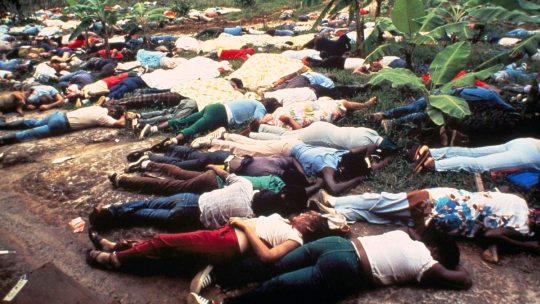
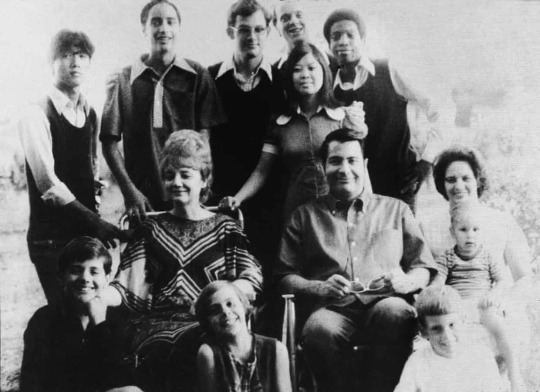
Jonestown Massacre
The Jonestown massacre was, before 9/11, the largest single incident of intentional civilian death in American history. More than 900 people died, many children. It was also a devastating cultural trauma: the end of the last strains of a certain kind of 1960s idealism and 1970s radicalism. Jonestown’s legacy lives on in the ironic phrase “drink the Kool-Aid”. (In actuality it was Fla-Vor-Aid.)
Although he would later become a symbol of the darker side of the west coast counterculture, Jim Jones was born to a poor family in Indiana. Described as an intelligent and strange child, Jones was instinctively attracted to religion, especially charismatic Christian traditions like Pentecostalism. He cut his teeth as a street preacher, and was, unusually for the time and place, a passionate advocate for racial equality. Jones’s idiosyncratic blend of evangelical Christianity, New Age spirituality and radical social justice attracted an enthusiastic following. He called his burgeoning church the Peoples Temple.
Although Jones’s followers would later be stereotyped as sinister, brainwashed idiots, the journalist Tim Reiterman argues in his seminal book on the subject that many were “decent, hardworking, socially conscious people, some highly educated”, who “wanted to help their fellow man and serve God, not embrace a self-proclaimed deity on earth”. The Peoples Temple advocated socialism and communitarian living and was racially integrated to an exceptional standard rarely matched since.
In 1965, when Jones was in his mid-30s, he ordered the Peoples Temple moved to California. He drifted away from traditional Christian teachings, describing himself in messianic terms and claiming he was the reincarnation of figures like Christ and Buddha. He also claimed that his goal all along was communism, and, in a twist on the famous dictum that religion is the “opiate of the masses”, that religion was merely his way of making Marxism more palatable.
By the 1970s, the Peoples Temple, now based in San Francisco, had gained significant political influence. Jones’s fierce advocacy for the downtrodden earned him the admiration of left-wing icons like Angela Davis and Harvey Milk and the support of groups like the Black Panthers – a tragically misguided political affinity, given that more than two-thirds of Jonestown’s eventual victims were African American.
There were signs, however, of a sinister undercurrent to the Peoples Temple. Followers were expected to devote themselves completely to the church’s utopian project: they turned over their personal wealth, worked long hours of unpaid labor for the church and often broke contact with their families. They were expected to raise their children within the commune. As a show of commitment, Peoples Temple members were asked to sign false testimonials that they had molested their children, which the church kept for potential blackmail.
In his 1980 study of Jonestown, the writer Shiva Naipaul, younger brother of VS Naipaul, argued that the Peoples Temple was at heart a fundamentalist religious project – “obsessed with sin and images of apocalyptic destruction, authoritarian in its innermost impulses, instinctively thinking in terms of the saved and the damned”.
The result, Naipaul wrote, “was neither racial justice nor socialism but a messianic parody of both”.
Jones, who had long believed the US was in danger of imminent nuclear holocaust, had been searching for a place where his church would be “safe” during an apocalyptic event. A magazine article alleging abuse in the Peoples Temple spurred Jones’s desire to relocate. He chose Guyana, a former British colony in South America whose socialist regime was politically sympathetic.
In 1977 the Peoples Temple moved its headquarters to a remote area of Guyanese wilderness. Here, Jones declared, they could build a utopian society without government or media meddling. Battling an oppressive tropical climate and limited resources, they began to convert the dense jungle into a working agricultural commune, soon known as “Jonestown”.
The church delivered Jones’s rambling monologues to Jonestown’s inhabitants by megaphone as they worked. In the evenings they attended mandatory propaganda classes. Jones’s writ was enforced by armed guards called the “Red Brigade”.
Jonestown had little reason to expect interference from Guyana – a “cooperative republic” whose government happily ignored signs of the cult’s authoritarian and paranoid bent. Back in the US, however, parents of Jonestown inhabitants – concerned by the strange letters, or lack of letters, they received from their children – had been lobbying the government to investigate. After a family in the US won a custody order for a child in Jonestown, paranoia escalated. The commune became an armed camp, ringed by volunteers with guns and machetes, threatening to fight outsiders to the death.
During the siege, Black Panthers Huey Newton and Angela Davis spoke to Jonestown inhabitants by radio patch to voice solidarity. Davis told Jonestown inhabitants that they were at the vanguard of revolution, and right to resist what she called “a profound conspiracy” against them.
Sometime during this period Jonestown began drills called “white nights”, in which inhabitants would practice committing mass suicide.
At the behest of concerned family members in the US, the California congressman Leo Ryan organized a delegation of journalists and others to make a fact-finding mission to Jonestown.
The delegation arrived at Jonestown on 17 November 1978 and received a civil audience from Jones, but the visit was hastily called short on 18 November after a member of the commune tried to stab Ryan. The delegation headed back to the airstrip, accompanied by a dozen Jonestown inhabitants who had asked to leave the commune, and escorted by Jones’s watchful deputies.
The delegates never made it off the ground. As they boarded the planes, their escorts drew guns and opened fire. They shot Ryan dead, combing his body with bullets to make certain, and killed four others – including two photographers who captured footage of the attack before dying. Wounded survivors ran or dragged themselves, bleeding, into the forest. (One of Ryan’s aides, Jackie Speier, survived five gunshots and is now a congresswoman representing California’s 14th district.)
Back at Jonestown, Jones announced that it was time to undertake the final “white night”. To quell disagreement, he told inhabitants that Congressman Ryan had already been murdered, sealing the commune’s fate and making “revolutionary suicide” the only possible outcome.
The people of Jonestown, some acceptant and serene, others probably coerced, queued to receive cups of cyanide punch and syringes. The children – more than 300 – were poisoned first, and can be heard crying and wailing on the commune’s own audio tapes, later recovered by the FBI.
When Guyanese troops reached Jonestown the next morning, they discovered an eerie, silent vista, frozen in time and littered with bodies. A tiny number of survivors, mainly people who had hidden during the poisoning, emerged. One elderly woman, who slept through the entire ordeal, awoke to discover everyone dead. Jones was found dead of an apparently self-inflicted gunshot.
48 notes
·
View notes
Text

Jonestown Massacre
The Jonestown massacre was, before 9/11, the largest single incident of intentional civilian death in American history. More than 900 people died, many children. It was also a devastating cultural trauma: the end of the last strains of a certain kind of 1960s idealism and 1970s radicalism. Jonestown’s legacy lives on in the ironic phrase “drink the Kool-Aid”. (In actuality it was Fla-Vor-Aid.)
Although he would later become a symbol of the darker side of the west coast counterculture, Jim Jones was born to a poor family in Indiana. Described as an intelligent and strange child, Jones was instinctively attracted to religion, especially charismatic Christian traditions like Pentecostalism. He cut his teeth as a street preacher, and was, unusually for the time and place, a passionate advocate for racial equality. Jones’s idiosyncratic blend of evangelical Christianity, New Age spirituality and radical social justice attracted an enthusiastic following. He called his burgeoning church the Peoples Temple.
Although Jones’s followers would later be stereotyped as sinister, brainwashed idiots, the journalist Tim Reiterman argues in his seminal book on the subject that many were “decent, hardworking, socially conscious people, some highly educated”, who “wanted to help their fellow man and serve God, not embrace a self-proclaimed deity on earth”. The Peoples Temple advocated socialism and communitarian living and was racially integrated to an exceptional standard rarely matched since.
In 1965, when Jones was in his mid-30s, he ordered the Peoples Temple moved to California. He drifted away from traditional Christian teachings, describing himself in messianic terms and claiming he was the reincarnation of figures like Christ and Buddha. He also claimed that his goal all along was communism, and, in a twist on the famous dictum that religion is the “opiate of the masses”, that religion was merely his way of making Marxism more palatable.
By the 1970s, the Peoples Temple, now based in San Francisco, had gained significant political influence. Jones’s fierce advocacy for the downtrodden earned him the admiration of left-wing icons like Angela Davis and Harvey Milk and the support of groups like the Black Panthers – a tragically misguided political affinity, given that more than two-thirds of Jonestown’s eventual victims were African American.
There were signs, however, of a sinister undercurrent to the Peoples Temple. Followers were expected to devote themselves completely to the church’s utopian project: they turned over their personal wealth, worked long hours of unpaid labor for the church and often broke contact with their families. They were expected to raise their children within the commune. As a show of commitment, Peoples Temple members were asked to sign false testimonials that they had molested their children, which the church kept for potential blackmail.
In his 1980 study of Jonestown, the writer Shiva Naipaul, younger brother of VS Naipaul, argued that the Peoples Temple was at heart a fundamentalist religious project – “obsessed with sin and images of apocalyptic destruction, authoritarian in its innermost impulses, instinctively thinking in terms of the saved and the damned”.
The result, Naipaul wrote, “was neither racial justice nor socialism but a messianic parody of both”.
Jones, who had long believed the US was in danger of imminent nuclear holocaust, had been searching for a place where his church would be “safe” during an apocalyptic event. A magazine article alleging abuse in the Peoples Temple spurred Jones’s desire to relocate. He chose Guyana, a former British colony in South America whose socialist regime was politically sympathetic.
In 1977 the Peoples Temple moved its headquarters to a remote area of Guyanese wilderness. Here, Jones declared, they could build a utopian society without government or media meddling. Battling an oppressive tropical climate and limited resources, they began to convert the dense jungle into a working agricultural commune, soon known as “Jonestown”.
The church delivered Jones’s rambling monologues to Jonestown’s inhabitants by megaphone as they worked. In the evenings they attended mandatory propaganda classes. Jones’s writ was enforced by armed guards called the “Red Brigade”.
Jonestown had little reason to expect interference from Guyana – a “cooperative republic” whose government happily ignored signs of the cult’s authoritarian and paranoid bent. Back in the US, however, parents of Jonestown inhabitants – concerned by the strange letters, or lack of letters, they received from their children – had been lobbying the government to investigate. After a family in the US won a custody order for a child in Jonestown, paranoia escalated. The commune became an armed camp, ringed by volunteers with guns and machetes, threatening to fight outsiders to the death.
During the siege, Black Panthers Huey Newton and Angela Davis spoke to Jonestown inhabitants by radio patch to voice solidarity. Davis told Jonestown inhabitants that they were at the vanguard of revolution, and right to resist what she called “a profound conspiracy” against them.
Sometime during this period Jonestown began drills called “white nights”, in which inhabitants would practice committing mass suicide.
At the behest of concerned family members in the US, the California congressman Leo Ryan organized a delegation of journalists and others to make a fact-finding mission to Jonestown.
The delegation arrived at Jonestown on 17 November 1978 and received a civil audience from Jones, but the visit was hastily called short on 18 November after a member of the commune tried to stab Ryan. The delegation headed back to the airstrip, accompanied by a dozen Jonestown inhabitants who had asked to leave the commune, and escorted by Jones’s watchful deputies.
The delegates never made it off the ground. As they boarded the planes, their escorts drew guns and opened fire. They shot Ryan dead, combing his body with bullets to make certain, and killed four others – including two photographers who captured footage of the attack before dying. Wounded survivors ran or dragged themselves, bleeding, into the forest. (One of Ryan’s aides, Jackie Speier, survived five gunshots and is now a congresswoman representing California’s 14th district.)
Back at Jonestown, Jones announced that it was time to undertake the final “white night”. To quell disagreement, he told inhabitants that Congressman Ryan had already been murdered, sealing the commune’s fate and making “revolutionary suicide” the only possible outcome.
The people of Jonestown, some acceptant and serene, others probably coerced, queued to receive cups of cyanide punch and syringes. The children – more than 300 – were poisoned first, and can be heard crying and wailing on the commune’s own audio tapes, later recovered by the FBI.
When Guyanese troops reached Jonestown the next morning, they discovered an eerie, silent vista, frozen in time and littered with bodies. A tiny number of survivors, mainly people who had hidden during the poisoning, emerged. One elderly woman, who slept through the entire ordeal, awoke to discover everyone dead. Jones was found dead of an apparently self-inflicted gunshot.
15 notes
·
View notes
Text







an offering (2023) Suchitra Mattai
#art#art stuff#museum#art appreciation#art history#suchitra mattai#fine art#textile art#textiles#fabric art#fabric#incredible#guyana art#guyanese
15 notes
·
View notes
Text
I am an African American woman who is also half Guyanese. I feel a deep need to visit Guyana because I know nothing about my roots. As a solo traveler currently in South America, I’ve been reflecting on my identity and experiences.
Being American can be embarrassing at times due to the ignorance we often exhibit. More of us need to travel, as doing so can broaden our perspectives and reduce our ignorance, provided we engage with locals and are open to learning. There is so much our history textbooks didn’t teach us and even lied about. America and Americans have a troubling reputation worldwide. When I ask people from other countries about racism, they often say it’s primarily an American issue (not that it doesn’t exist elsewhere, but we seem particularly fixated on race, and I understand why).
We need to realize that two things can be true at once and that everyone's experiences are valid. We should not try to fit others into boxes just to make ourselves comfortable. This lesson has been one of the greatest I’ve learned from traveling.
Stay blessed. 💚
4 notes
·
View notes
Text
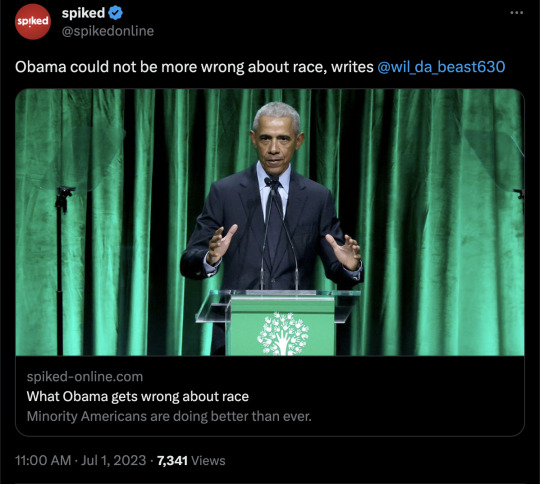
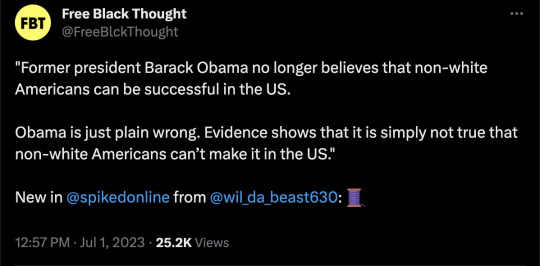





By: Wilfred Reilly
Published: Jun 28, 2023
Former president Barack Obama no longer believes that non-white Americans can be successful in the US.
I am being a bit glib, but only a bit. During a podcast interview last week with former Democratic Party apparatchik David Axelrod, Obama criticised Tim Scott, black Republican senator for South Carolina and 2024 presidential candidate. Scott is well-known for his optimism and belief in the American Dream, previously stating that ‘I know America is a land of opportunity, not a land of oppression’. Taking a clear swipe at Scott, Obama said: ‘I think there’s a long history of African American or other minority candidates within the Republican Party who will validate America and say, “Everything’s great, and we can make it”.’
According to Obama, that belief is untrue. Noting several elements of America’s racist past, Obama declared: ‘We can’t just ignore all that and pretend as if everything’s equal and fair. We actually have to walk the walk and not just talk the talk.’ Before signing off from the show, he went on to describe black and other ethnic minorities as ‘rightly sceptical’ of positive racial messages like those of Senator Scott.
Beyond the sheer bizarreness of a former national leader describing his own country as a racist hole, Obama is just plain wrong. Evidence shows that it is simply not true that non-white Americans can’t make it in the US.
This claim is quickly disproven by a look at the Census Bureau’s lists of household income by ethnicity. The wealthiest population group in the US is not white Americans, but rather Indian Americans. This group brings in a median household income of $142,000 annually, in comparison to just under $75,000 for Caucasians. The second-richest group is Taiwanese Americans, who pull down $119,000 per year for each household. In fact, most of the top 10 highest-earning groups (and all of those consistently averaging six figures per year) are racial minorities – Indians, the Taiwanese, Filipinos ($101,000), Pakistanis ($102,000), Sri Lankans ($97,000), Iranians ($96,000) and Chinese Americans ($93,000).
In contrast, one of the poorer groups listed is white Appalachian Americans, at $50,000 per home per year. On the other hand, black immigrants tend to do fairly well, with the Guyanese, Ghanaians, Barbadians, Trinidadians and Nigerians all coming in at above the $70,000 per year mark. Jamaicans ($66,000) and other West Indians ($64,000) also come close. Nigerian immigrants are one of the best-educated groups in the US, ahead of both Asian and white Americans.
African Americans do quite a bit worse. However, the median black household income as of 2021 – an Appalachia-like $47,000 – still ranks higher than the median household incomes for the UK, Austria and Italy. In any case, the high earnings of African and Caribbean immigrants demonstrate that African Americans’ low performance cannot be due to racism. Rather, it is largely down to the fact that black households tend to have fewer people in them.
The black single-motherhood / father-absence rate, at least at the time of birth, currently sits at a staggering 77 per cent. Simply put, a family consisting of a single mother and infant will earn less lucre than one that includes a husband, wife and employed teenagers. While this situation is far from ideal, there are still many individual black Americans, whether they come from stable families or not, who are extremely successful by any global or historical standard. Tim Scott was himself born into a poor, single-parent household and yet nonetheless managed to rise to the position of senator.
Obama’s ‘cannot succeed’ claim is strange given the reality of modern America, and given his own background and path through life. Simply put, Obama is not a descendant of American slaves. His mother was an upper-middle-class white woman from Kansas and his father was a prominent Kenyan economist. Obama grew up primarily in well-off enclaves, such as in upscale districts of Hawaii’s Honolulu and Indonesia’s Jakarta. Young Obama was surrounded by other wealthy non-white groups and expats. While this might be a little politically incorrect to say out loud, watching him try to explain the US black experience to Scott, a scion of the Carolina cotton country, borders on the surreal.
Interestingly, attitudes like Obama’s (although he didn’t always talk like this) seem to be getting more common among first- and second-generation minority immigrants to the US. This is despite the fact that most of these people have never had a ‘back of the bus’ experience in their lives. To give one typical example, writer and race activist Saira Rao started a fracas on Twitter last week by saying:
‘White people love to say “not everything is about race”. This from the people who committed genocide of Indigenous people, genocide and enslavement of African people. Those behind the Chinese Exclusion Act, Operation Wetback and the Muslim ban. You made everything about racism.’
The remarkable thing about this claim is that even those events on Rao’s list that did happen (US black genocide and a national ‘Muslim ban’ are simply made up) will not have impacted her in any way. Rao is a second-generation Indian American. Only the Exclusion Act might have been potentially relevant to a legal immigrant from Asia. And even then, the act was passed in 1882 and formally repealed 80 years ago. Attitudes like Rao’s are part of a broader trend of post-1965 migrants making embarrassing attempts to link themselves to historical slavery or Jim Crow.
However silly they may sound, the beliefs held by the likes of Obama and Rao can have serious negative impacts. Imagine being told for almost all your life that you are unlikely to succeed. That every social interaction is rigged against you. That the people who seem like your closest football and lunchroom buddies are likely liars and secret racists. How might this affect you?
Hard data give a clear answer. A 2021 study found that these demoralising takes have a real, measurable impact on people. Simply reading a typical despairing passage about ‘systemic racism’ from woke authors like Ta-Nehisi Coates resulted ‘in a significant, 15-point drop in black respondents’ belief that they have control over their lives’. Worse still, we now teach precisely these ideas in schools, colleges and workplaces across the US, often in mandatory classes or training.
At the heart of this discussion is what Thomas Sowell once called ‘a conflict of visions’. The US faces a choice about what to tell new and aspiring citizens about our society. Are we a flawed but ultimately good country, where people of all colours and persuasions can thrive? Or is the US a genocidal racial-caste state, which should be constantly trying to atone for its historical sins?
Let us sincerely hope that we choose to embrace the first vision over the second.
-
Wilfred Reilly is a spiked columnist and the author of Taboo: 10 Facts You Can’t Talk About, published by Regnery. Follow him on Twitter: @wil_da_beast630
==
Remind me again... in which direction do people migrate, as far as western countries are concerned? To or from? /s
#Wilfred Reilly#Barack Obama#systemic racism#victimhood culture#victimhood complex#victimhood#wokeism#woke#cult of woke#wokeness#wokeness as religion#antiracism as religion#antiracism#religion is a mental illness
11 notes
·
View notes
Photo

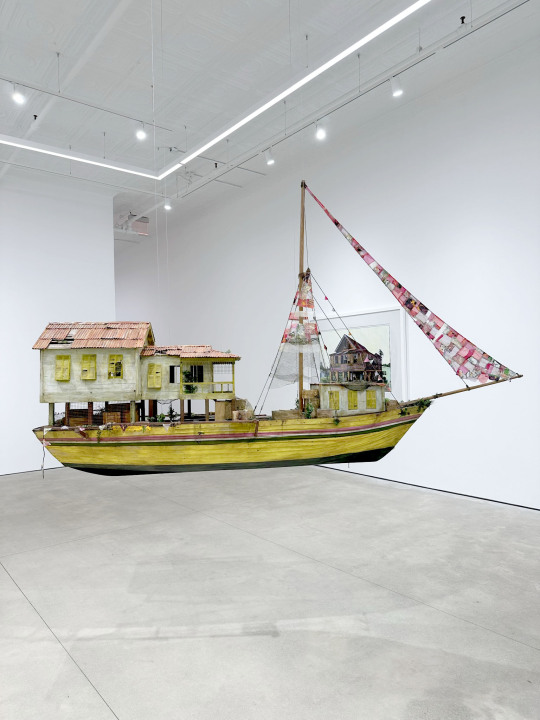
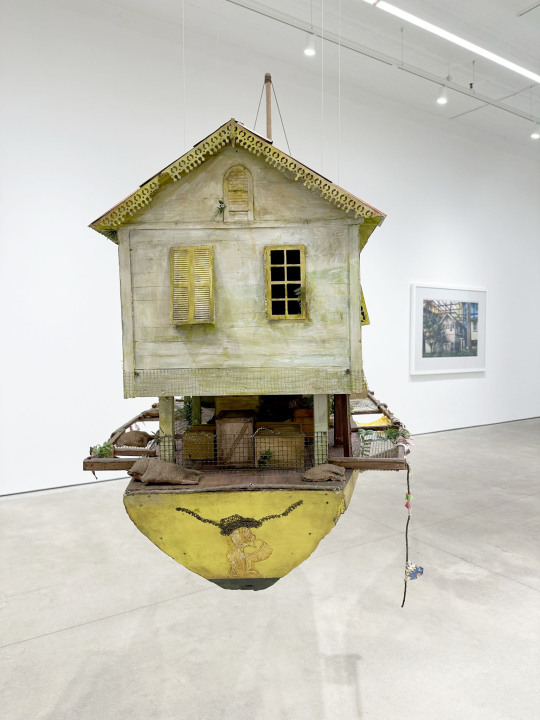





For Hew Locke’s exhibition, Listening to the Land, at P.P.O.W. he has created intricate sculptures and paintings that are fascinating in person.
From the press release-
Locke is known for exploring the languages of colonial and post-colonial power, and the symbols through which different cultures assume and assert identity. Furthering the themes explored in his celebrated commission The Procession at Tate Britain, and his concurrent installation Gilt on the façade of The Metropolitan Museum of Art, this exhibit engages with contemporary and historical inequities while reflecting on the landscape and history of the Caribbean. The exhibition draws its title from a poem by Guyanese political activist and poet Martin Carter which situates itself between two opposing forces of the landscape – sea and forest. Locke’s show features new sculptures and wall works with recurring motifs of stilt-houses, boats, memento mori, and share certificates referencing tensions between the land, the sea, and economic power. Reflecting on these links, Locke notes, “The land was created to generate money for colonial power, now the sea wants it back.”
Translating to ‘land of many waters,’ Guyana and its physical, economic, and political landscape serve as one of the primary sources for Locke’s work. Having spent his childhood in this newly independent nation, the artist witnessed first-hand an era of radical transformation. Now, the country teeters on the precipice of an oil boom and is one of the world’s fastest growing economies. Juxtaposing personal meditations on the climate crisis with political commentary on the history of a globalized world, Locke contemplates the ways in which colonies were exploited to accumulate capital, and observes how Guyana’s economic future lies in the exploitation of its waters. Locke’s new boat sculptures The Relic and The Survivor embody this broad worldview as the two battered wrecks drift through time and history. Evoking the fragmented and diverse legacies of the global diaspora, the boats’ patchwork sails are interspersed with photo transfers of 19th Century cane cutters and banana boat loaders, while their decks are loaded with cargo that could allude to colonial plunder, trade goods or personal belongings.
Based on an abandoned plantation house, Locke’s newest sculpture Jumbie House 2 features layered images that unveil the spirits that haunt this colonial vestige. Presented alongside are a series of painted photographs of dilapidated vernacular architecture across Georgetown and rural Guyana. Constantly under threat of being washed away by storms or rising sea levels, these crumbling structures echo anxieties surrounding climate change and historical erasure. A new series of mixed media wall works, Raw Materials, is derived from antique share certificates and bonds. Locke richly decorates the appliques with acrylic, beads, and patchwork to draw attention to the complex ways in which the past shapes the present. The image of an 1898 Chinese Imperial Gold Loan behind painted Congolese figures connects the global economy at the height of Empire to current Sino-African trade networks. In another work, a painted representation of a Nigerian Ife mask, alongside an image of David Livingstone, is layered on a French-African Mortgage Bond from 1923, connecting exploration and exploitation of African land, to current conversations surrounding the repatriation of artifacts. Taken together, the works in Locke’s Listening to the Land echo William Faulkner’s adage “The past is never dead. It’s not even past.”
This exhibition closes 4/1/23.
The Procession, mentioned above, can now be seen at Baltic Centre for Contemporary Art, in Gateshead, England until June 11th, 2023.
Gilt, also mentioned above, is on view at The Metropolitan Museum of Art until May 30th, 2023.
#hew locke#p.p.o.w#p.p.o.w gallery nyc#nyc art shows#sculpture#art installation#painting#guyana#baltic centre for contemporary art#the met#the metropolitan museum of art#uk art shows#art#art shows#models#photography#england art shows#gateshead#newcastle
15 notes
·
View notes
Text
The Russian Revolution: A View from the Third World - Walter Rodney

Hello friends!
Today I'm excited to start Black History Month (which is really every month) by forefronting another phenomenal text by Walter Rodney: "The Russian Revolution, A View from the Third World"
As described before, Rodney was a prominent Guyanese historian, political activist, and scholar. He was born on March 23, 1942, in Georgetown, British Guiana (now Guyana). He's still an icon in Pan-Africanist and Marxist thought which al of us ought to engage.
This book provides a fresh, invaluable perspective on one of the most significant events of the twentieth century and socialist history overall. He approaches this subject with an eye towards rectifying the record on histories of the Soviet Union to see what, if any, lessons can be learned from their experiments and applied to decolonization efforts and socialist politics going forward.
Rodney starts by unpacking what an "African Perspective" on the Russian Revolution as opposed to Western European (and American) view would be and why it matters. He shows that integrating Marxist views alongside marginalized African perspectives lets us see the revolution in all its complexity, unlike the black-and-white picture of bourgeois scholarship.
The main body of the book really focuses on unpacking various historical accounts of Russian history pre and post-1917 to get a gleaming of what a more nuanced picture could be. Rodney does a great job at engaging figures on the Left seriously and offering his criticisms of failures constructively alongside defending the Soviets from the more outrageous propaganda.
One of my favorite bits of context for this text is that it was essentially the pre-figuration of another amazing book, "How Europe Underdeveloped Africa," as editor Robin D. G. Kelley noted in a talk with Vijay Prashad (who wrote the foreward) on YouTube y'all should check out.
Rodney saw the Soviet experiment as an essential starting point for his investigation into making revolution across Africa, not a side issue. This became even more relevant for his struggles in Guyana, where he died in 1980 after pushing for socialism at home. Highly recommend this text for all of these lessons and histories!
3 notes
·
View notes